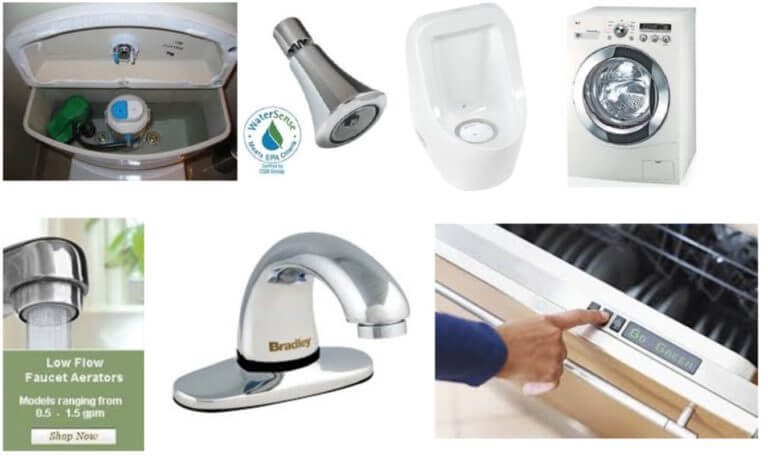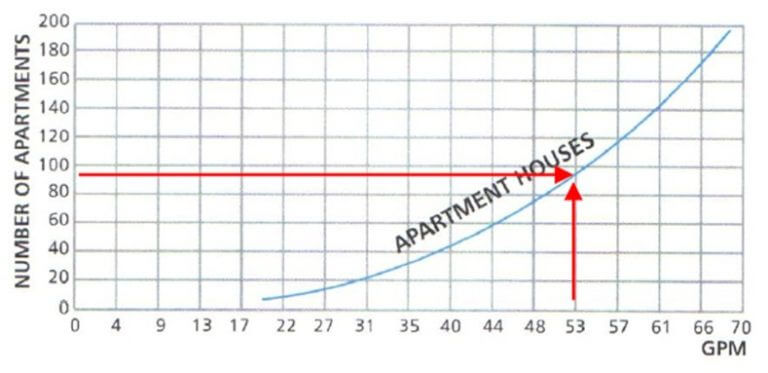
Sizing booster pumps for multi-family buildings
By Dennis Whitelaw, President, Towle Whitney LLC
The is not a standard discussion about the Hunter curves, sizing matrix, plumbing code requirements, blah, blah blah. This is an article for engineers, contractors, and facility owners that are curious about an alternate sizing method. Towle Whitney has been using this method for FIFTEEN YEARS, with 100% success. Specifically, we’ve never undersized a system.
Background
Ask most engineers; and they’ll tell you straight out: “I size the piping and the equipment based on the plumbing code requirements, because that’s what I ‘m required to do” (for example, reference picture with 4″ RPZ with 1-1/2″ pump). I find it fascinating that engineers, with four years of a rigorous M.E. degree, a few more years of apprenticing, and a tough examination process for the “stamp”, would be constrained by outdated plumbing codes and ancient theory.
Reality
Those same engineers will say in the same breath: ” I realize everything is over-sized….”. More amazing is that the plumbing community has not completed a comprehensive study of existing buildings to determine the ACTUAL usage. For example; what if we actually digitally metered these buildings around the country, and learned what the usage is hour by hour:
- 100 condominium buildings
- 100 apartment buildings
- 100 dormitories

Obviously there are a number of variables, but with this type of data, including number of units, occupancy rates, etc., we could develop a more realistic curve.

Throw in a bunch of water saving fixtures (1.5 gpm toilets, 1gpm showers, waterless urinals, low flow faucets, front load washers, and now low-flow dishwashers, and it’s no wonder we’re using a lot less water (despite washing our hands continuously).
Three Sizing Methods
I’ve been teaching this topic for ten years to numerous ASPE groups around the country, which results in a spirited and healthy discussion. Let’s look at three methods for sizing an 88 unit apartment building, averaging two people per unit.
IPC Fixture Count Method
- 3.6 fu load Bathroom Group
- 1.4 fu load Kitchen Sink
- 1.4 fu load Dishwasher
- 6.4 fu load / Apartment
- X 88
- 563 Water Supply FU
- 140 gpm demand(extrapolated from table E103.3)
This is a very different perspective from the standard IPC method, as the assumption is based on how much water a person uses per day. According to the US Environmental Protection Agency, the average water usage for a US citizen is about 70 gallons of water per day. In this example, we’ll use ALL of the 70 gallons in a four hour window to approximate a worst case scenario.
70 gpd / person
X 2
140 gpd / unit
X 88
12,320 gpd / building
/ 4 hours / day
3,080 gph
/ 60 minutes
51 gpm demand
Gould’s Curves
Gould’s (a Xylem company) actually developed a set of curves that we’ve been successfully using for over a decade. The single page covers numerous building types (office, hospitals, hotels), but we’ll focus on multi-family apartments / condominiums. Interestingly, the rate is not linear, as the more units in a building, the lower the usage / unit.

Usage summary
- 146 gpm IPC Fixture count
- 51 gpm Septic System
- 53 gpm Gould’s Graph
If we use the fixture count method, the system will be 3X larger than necessary. In light of this, we would recommend a:
- 100 gpm DUPLEX (50gpm / pump)
- 70 gpm SIMPLEX
PERFECT SYSTEM
For 88-200 units, and depending on the boost required, a 2Hp to 3Hp duplex system is usually the perfect choice.
Our most popular size is a 2Hp duplex. For example, our model: TW2975T-140R-40
- 70gpm/pump
- 40psi of boost
- 3″ Type “L” Manifolds
- Dual 2″ RPZ’s with integral 3″ DWV piping
- VFD controlled (alternate every 24 hours)
- No UL508 panel or PLC
- 26 gallon non-ASME tank
- 29″ x 40″ footprint
Conclusion
Smaller Hp pumps are:
- Less expensive to install
- Less expensive to maintain
- More energy efficient
- Quieter
- Require less space

The plumbing industry only advances by questioning the status-quo. We’ve proven for over a decade that a smaller horsepower system can deliver better performance and increased energy savings over the old school “bigger is better” approach. We sincerely appreciate any feedback.
